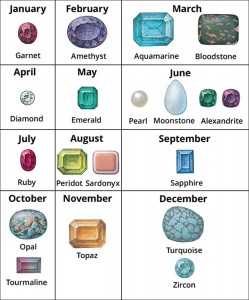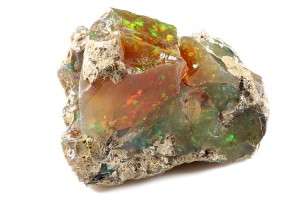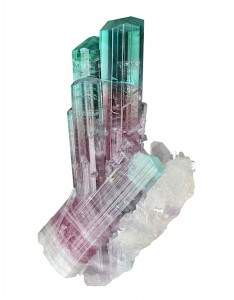An October of Opals & Tourmalines
October 21, 2019
If your birthday is in October, your birthstones—the gems associated with the month of your birth—are the opal and the tourmaline. Opal is a glassy material, some of which is valued as a gem for its flashes of color. It consists of water and a mineral called silica, the most common ingredient in sand. The tourmaline is any of a group of boron-containing minerals often found in granite. Tourmalines are used as gemstones and for industrial purposes.
Traditionally, opals have been worn by royalty and others of importance, and the gems were prized for their brilliant colors and translucent qualities. Many people thought opals were beneficial to the eye, and they were worn to cure eye diseases. Some people believed opals attracted money, and that they could make a person invisible. Thus they were popular with thieves. Black opals were thought to aid magicians or practicers of supernatural “black arts.”
Much opal is white, gray, brown, or black. Some opal shows a brilliant flash of color, called play of color, on top of its background color. Opal with play of color is called precious opal. Opal without color play has little or no gem value, unless it is clear or brightly colored. Opal without gem value is called common opal or potch. Australia is the main modern source of opals, but they can be found in many parts of the world. One of the largest opals ever found, the Andamooka Desert Flame, weighed over 15 pounds (6.8 kilograms) when found in Australia in 1969.
The tourmaline, sometimes called the rainbow of gemstones, has traditionally been worn as a jewel of love, protection, and harmony. The gems were also thought to help people connect with their inner selves, and thus the tourmaline aided with self-realization and understanding.
Tourmalines vary greatly in color. The most common tourmalines include elbaite, dravite, and schorl. Elbaite, which is rich in lithium, can appear pink, blue, green, or yellow. Dravite, a magnesium-rich tourmaline, usually appears brownish. Schorl, rich in iron and manganese, is usually black. The color of some tourmaline crystals varies from the center to the edges. Watermelon tourmaline, for example, appears pink in the center and green at the edges. These changes indicate a change in conditions as the crystal formed.
Tourmaline is piezoelectric—that is, its crystals can develop an electric charge when stretched or squeezed. Tourmaline has been used in radio transmitters and pressure sensors. Scientists use slices of tourmaline in the study of polarized light (light that vibrates in a single direction). Jewelers commonly cut transparent and flawless tourmaline crystals into gems. Main sources for tourmalines include Brazil, India, Sri Lanka, and several countries in Africa.

Click to view larger image
Birthstones, according to tradition, bring good luck when worn by a person born in the associated month. Credit: WORLD BOOK illustrations by Paul D. Turnbaugh
According to tradition, a birthstone brings good luck to a person born in its month. Each birthstone also corresponds to a sign of the zodiac. The belief in birthstones may have come from a Bible story about Aaron, the first high priest of the Israelites. The story describes Aaron’s breastplate, which was decorated with 12 precious stones. Early writers linked these stones with the 12 months of the year and the 12 signs of the zodiac. The custom of wearing a stone that represented a person’s zodiac sign probably originated in Germany or Poland in the 1700′s.




